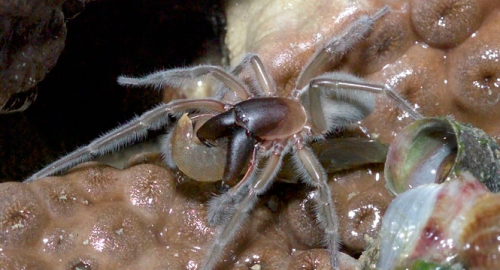This week, National Geographic magazine asks the question, “How much life could you find in one cubic foot [of any given natural space]?” To this end, photographer David Liittschwager brought a one cubic foot metal frame to five natural habitats; a deciduous forest, a coral reef, a tropical cloud forest, a mountain, and a fresh water stream. He placed the cube and went about photographing and cataloging every living creature within it; a process that took weeks at each location.
The results are wondrous.
 This is a collage of some of the animals found in the Moorean reef cube. Bonus points if you can spot the two stomatopods!
This is a collage of some of the animals found in the Moorean reef cube. Bonus points if you can spot the two stomatopods!
Online, Nat Geo also has a video about the production of the Central Park deciduous forest segment and a unsurprisingly great article about the importance of biodiversity from E. O. Wilson.
I think this project nicely communicates exactly how unbelievably diverse and awesome life on Earth is. Most people, who don’t make their living wading through biodiversity, likely perceive of ecosystems as consisting of plants, chordates, a few token species of arthropods and worms, and some ambiguous bacteria churning its way through dead stuff.
But look at the diversity in these tiny cubic microcosms! Look at the variety of arthropods! This article pushes the staggering numerical diversity of animal species right into your face. Endless forms most beautiful, indeed!
 I imagined a similar concept last summer while I was splitting rubble looking for mantis shrimp on the Great Barrier Reef. Every time I cracked open a rock it was like hitting a biodiversity piñata. Out flew endless species of crabs, pistol shrimp, isopods, amphipods, mantis shrimp, fish, worms, mollusks, and echinoderms. I couldn’t help but wonder, what if someone painstakingly categorized every living animal in a single hunk of rock off of this reef? How astonishing would the final tally be, and how could such a feat be accomplished?
I imagined a similar concept last summer while I was splitting rubble looking for mantis shrimp on the Great Barrier Reef. Every time I cracked open a rock it was like hitting a biodiversity piñata. Out flew endless species of crabs, pistol shrimp, isopods, amphipods, mantis shrimp, fish, worms, mollusks, and echinoderms. I couldn’t help but wonder, what if someone painstakingly categorized every living animal in a single hunk of rock off of this reef? How astonishing would the final tally be, and how could such a feat be accomplished?
The study of biodiversity levels is a tremendous potential application for the current genetic barcoding initiatives. These groups aim to compile a genetic marker database, making it possible to identify any species of animal on earth by sequencing a single chunk of the CO1 gene from its tissue. Someday, this technology will be able to accomplish high-throughput environmental biodiversity screening, allowing us to quickly and empirically measure biodiversity levels in given habitats. This is a truly exciting horizon for ecological research.
Via, iescience.



















